Selective silencing of Na(V)1.7 decreases excitability and conduction in vagal sensory neurons
- PMID: 22005676
- PMCID: PMC3249041
- DOI: 10.1113/jphysiol.2011.215384
Selective silencing of Na(V)1.7 decreases excitability and conduction in vagal sensory neurons
Abstract
There has been much information learned in recent years about voltage gated sodium channel (Na(V)) subtypes in somatosensory pain signalling, but much less is known about the role of specific sodium channel subtypes in the vagal sensory system. In this study, we developed a technique using adeno-associated viruses (AAVs) to directly introduce shRNA against Na(V)1.7 subtype gene into the vagal sensory ganglia of guinea pigs in vivo. Na(V)1.7 gene expression in nodose ganglia was effectively and selectively reduced without influencing the expression of other sodium channel subtype genes including Na(V)1.1, 1.2, 1.3 1.6, 1.8, or 1.9. Using a whole cell patch-clamp technique, this effect on Na(V)1.7 gene expression coincided with a reduction in tetrodotoxin-sensitive sodium current, a requirement for much larger depolarizing stimulus to initiate action potentials, and reduction in repetitive action potential discharge. Extracellular recordings in the isolated vagus nerve revealed that the conduction of action potentials in sensory A- and C-fibres in many neurons was effectively abolished after Na(V)1.7 shRNA introduction. Moreover, bilateral Na(V)1.7 shRNA injected animals survived for several months and the vagal reflex behaviour, exemplified by citric acid-induced coughing, was significantly suppressed. These data indicate that selectively silencing Na(V)1.7 ion channel expression leads to a substantial decrease in neural excitability and conduction block in vagal afferent nerves.
Keywords: nav1.7.
Figures
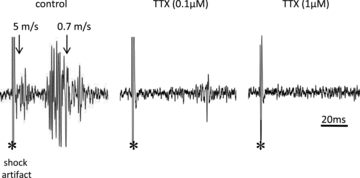
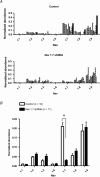
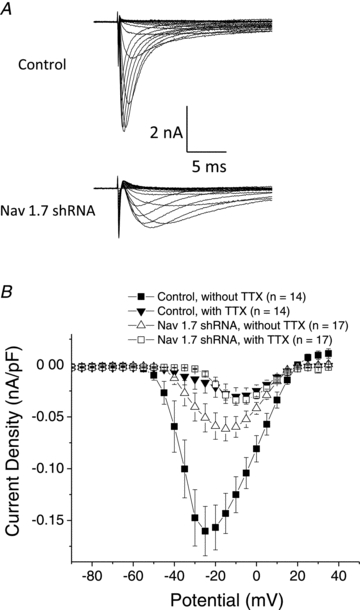


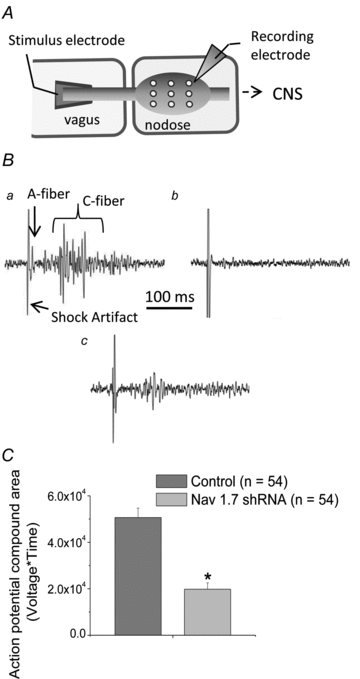
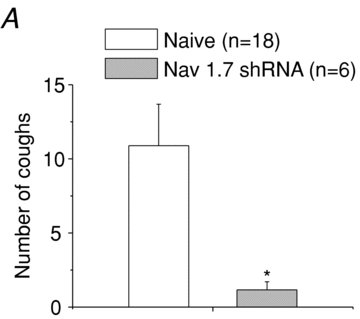
Similar articles
-
Selective inhibition of vagal afferent nerve pathways regulating cough using Nav 1.7 shRNA silencing in guinea pig nodose ganglia.Am J Physiol Regul Integr Comp Physiol. 2013 Jun 1;304(11):R1017-23. doi: 10.1152/ajpregu.00028.2013. Epub 2013 Apr 10. Am J Physiol Regul Integr Comp Physiol. 2013. PMID: 23576611 Free PMC article.
-
Voltage-gated sodium channels in nociceptive versus non-nociceptive nodose vagal sensory neurons innervating guinea pig lungs.J Physiol. 2008 Mar 1;586(5):1321-36. doi: 10.1113/jphysiol.2007.146365. Epub 2008 Jan 10. J Physiol. 2008. PMID: 18187475 Free PMC article.
-
KATP channels in the nodose ganglia mediate the orexigenic actions of ghrelin.J Physiol. 2015 Sep 1;593(17):3973-89. doi: 10.1113/JP270788. J Physiol. 2015. Retraction in: J Physiol. 2023 May;601(10):2049. doi: 10.1113/JP284696. PMID: 26174421 Free PMC article. Retracted.
-
Involvement of Na+ channels in pain pathways.Trends Pharmacol Sci. 2001 Jan;22(1):27-31. doi: 10.1016/s0165-6147(00)01585-6. Trends Pharmacol Sci. 2001. PMID: 11165669 Review.
-
Sensory neuron voltage-gated sodium channels as analgesic drug targets.Curr Opin Neurobiol. 2008 Aug;18(4):383-8. doi: 10.1016/j.conb.2008.08.017. Epub 2008 Oct 3. Curr Opin Neurobiol. 2008. PMID: 18824099 Review.
Cited by
-
Validating therapeutic targets through human genetics.Nat Rev Drug Discov. 2013 Aug;12(8):581-94. doi: 10.1038/nrd4051. Epub 2013 Jul 19. Nat Rev Drug Discov. 2013. PMID: 23868113 Review.
-
Mechanisms and Rationale for Targeted Therapies in Refractory and Unexplained Chronic Cough.Clin Pharmacol Ther. 2021 Mar;109(3):619-636. doi: 10.1002/cpt.2003. Epub 2020 Aug 28. Clin Pharmacol Ther. 2021. PMID: 32748976 Free PMC article. Review.
-
Mapping of the Sensory Innervation of the Mouse Lung by Specific Vagal and Dorsal Root Ganglion Neuronal Subsets.eNeuro. 2022 Apr 13;9(2):ENEURO.0026-22.2022. doi: 10.1523/ENEURO.0026-22.2022. Print 2022 Mar-Apr. eNeuro. 2022. PMID: 35365503 Free PMC article.
-
Targeting voltage gated sodium channels NaV1.7, Na V1.8, and Na V1.9 for treatment of pathological cough.Lung. 2014 Feb;192(1):15-20. doi: 10.1007/s00408-013-9533-x. Epub 2013 Nov 24. Lung. 2014. PMID: 24272479 Free PMC article. Review.
-
Cytokine-specific Neurograms in the Sensory Vagus Nerve.Bioelectron Med. 2016;3:7-17. Bioelectron Med. 2016. PMID: 30003120 Free PMC article.
References
-
- Black JA, Renganathan M, Waxman SG. Sodium channel Nav1.6 is expressed along nonmyelinated axons and it contributes to conduction. Brain Res Mol Brain Res. 2002;105:19–28. - PubMed
-
- Caffrey JM, Eng DL, Black JA, Waxman SG, Kocsis JD. Three types of sodium channels in adult rat dorsal root ganglion neurons. Brain Res. 1992;592:283–297. - PubMed
-
- Canning BJ, Chou YL. Cough sensors. I. Physiological and pharmacological properties of the afferent nerves regulating cough. Handb Exp Pharmacol. 2009:23–47. - PubMed
Publication types
MeSH terms
Substances
Grants and funding
LinkOut - more resources
Full Text Sources
Other Literature Sources
Medical

